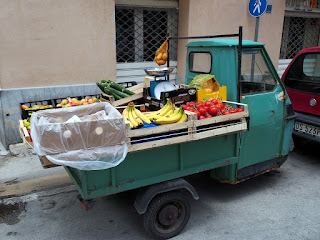Probably our favourite destination in Sicily, this
was our
longest stop and, luckily, our most interesting. The only place where we could
easily have stayed on for another week as there is so much to see and do. It is
an ancient port city with the old part jutting out on a flat and narrow peninsula
with the harbour on one side and beaches on the other. The unexciting bulk of the
city spreads inland in the usual unsightly modern apartment blocks, but we had
no need to venture there as everything worth seeing was a walk or bike ride from
our perfectly-placed apartment. Though it was on the third – and top - floor of
a smelly stairwell in a grotty alley (rubbish, feral cats, mad cat woman - no, not Vicki!), the interior
was good and it was only a few buildings away from the port on one side and the
main streets and beaches on the other side, yet very quiet as cars would have
struggled to get up the alley.
 |
| Vicki enjoying one of her Italian favourites - crema di caffe |
After walking with us to the apartment and showing us around, our hosts kindly left us with a couple of dozen pastries containing figs and a bottle of Marsala, a fortified wine. Marsala is a city to the south and we had seen many vines in that area as we travelled past in the bus. I enjoyed the dessert wine (like a sherry) but we had a bottle of "normal" white wine from that region and it was pretty tasteless.

Not surprisingly there were plenty of tourists around as the port has ferries to Tunisia, the Italian islands just off the north African coast, and up to Naples and Genoa, plus over to three nearby islands. Probably the highlight of our month was taking a boat for a day trip to the nearby islands. There were numerous large boats doing this (catering for 200-300 people each in peak season), but we found an old-style sailing ship (sadly only using its motors this time) that only took 30 people max. While the highlight may have been swimming from the boat in the turquoise waters, we also managed a tour of the island of Favignana by Noddy train! Given our
limited time there and the few drops of rain (one of only three short occurrences in a month) it turned out to be a great way of seeing the small island, despite understanding little of the commentary. We’ll remember it for the beautiful beaches and quarries everywhere: a lot of stone has been taken from here for building on the mainland. We also found that multi-tasking is not an exclusively female ability. Our [male] driver stopped for a coffee enroute and we saw him steering, gesticulating at the scenery, talking on his cellphone, holding the microphone, and drinking coffee almost all at the same time - quite a juggling act! Must be the Italian genes!
 On the edge of Trapani there are large salt pans. These get
flooded regularly and a few are still used to produce salt. There are some
windmills too that were used to pump the sea water around the pans. The area is
now a nature reserve and a stopping place for flamingos on their migration. As
we were the only ones in the area I thought I’d sneak up on a few to try to
get their portraits. Suddenly there were
several hundred airborne and two very sheepish tourists …
On the edge of Trapani there are large salt pans. These get
flooded regularly and a few are still used to produce salt. There are some
windmills too that were used to pump the sea water around the pans. The area is
now a nature reserve and a stopping place for flamingos on their migration. As
we were the only ones in the area I thought I’d sneak up on a few to try to
get their portraits. Suddenly there were
several hundred airborne and two very sheepish tourists … |
| Perspective issue - the tower in't about to fall! |
 |
| View east along the coast towards Palermo |
































